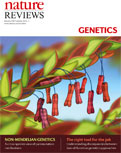|
| TABLE OF CONTENTS | |||||||||||||||||||||||||||||||||||||
| January 2017 Volume 18 Number 1 | |||||||||||||||||||||||||||||||||||||
2015 2-year Impact Factor 35.898 Journal Metrics 2-year Median 32 | In this issue
| ||||||||||||||||||||||||||||||||||||
| |||||||||||||||||||||||||||||||||||||
 | |||||||||||||||||||||||||||||||||||||
| Advertisement | |||||||||||||||||||||||||||||||||||||
| |||||||||||||||||||||||||||||||||||||
| |||||||||||||||||||||||||||||||||||||
| REVIEWS | Top | ||||||||||||||||||||||||||||||||||||
| Paramutation and related phenomena in diverse species Jay B. Hollick p5 | doi:10.1038/nrg.2016.115 In this Review, the author discusses current knowledge on the paramutations that occur in maize and contrasts these behaviours with potentially parallel examples in metazoans. He highlights the key role of small RNAs (sRNAs) in diverse paramutation mechanisms across eukaryotes and considers the evolutionary importance of these regulatory systems. Abstract | Full Text | PDF | Supplementary information | |||||||||||||||||||||||||||||||||||||
Loss-of-function genetic tools for animal models: cross-species and cross-platform differences Benjamin E. Housden et al. p24 | doi:10.1038/nrg.2016.118 Loss-of-function (LOF) approaches are powerful experimental tools for characterizing gene functions. However, emerging discrepancies when genes are investigated using different tools or organisms has triggered debate about how such LOF results should be biologically interpreted. In this Review, experts from varied fields discuss how understanding the underlying features of each LOF approach can provide explanations for different experimental outcomes and can guide their optimal and reliable application. Abstract | Full Text | PDF | |||||||||||||||||||||||||||||||||||||
| Microbial genome-wide association studies: lessons from human GWAS Robert A. Power, Julian Parkhill & Tulio de Oliveira p41 | doi:10.1038/nrg.2016.132 With the increasing availability of microbial whole genomes, researchers are beginning to carry out genome-wide association studies (GWAS) in bacteria, viruses and protozoa. In this Review, the authors discuss the specific challenges and considerations associated with the application of GWAS methods to microorganisms and consider the future of microbial GWAS in the light of lessons learned from human studies. Abstract | Full Text | PDF | |||||||||||||||||||||||||||||||||||||
From profiles to function in epigenomics Stefan H. Stricker, Anna Köferle & Stephan Beck p51 | doi:10.1038/nrg.2016.138 A wealth of data is emerging from diverse studies of epigenomics, including genome-scale profiles of DNA methylation, histone modifications and higher-order chromatin features. In this Review, the authors discuss how, despite all this information, many challenges remain for inferring and proving the physiological and pathological functions of chromatin states. They describe the degrees of 'functionality' that are revealed by different experimental approaches, the value of integrative strategies and visions for the future. Abstract | Full Text | PDF | Supplementary information | |||||||||||||||||||||||||||||||||||||
| |||||||||||||||||||||||||||||||||||||
| *2015 Journal Citation Report (Thomson Reuters, 2016) |
You have been sent this Table of Contents Alert because you have opted in to receive it. You can change or discontinue your e-mail alerts at any time, by modifying your preferences on your nature.com account at: www.nature.com/myaccount For further technical assistance, please contact our registration department For print subscription enquiries, please contact our subscription department For other enquiries, please contact our feedback department Nature Publishing Group | One New York Plaza, Suite 4500 | New York | NY 10004-1562 | USA Nature Publishing Group's worldwide offices: Macmillan Publishers Limited is a company incorporated in England and Wales under company number 785998 and whose registered office is located at The Campus, 4 Crinan Street, London, N1 9XW. © 2017 Nature Publishing Group, a division of Macmillan Publishers Limited. All Rights Reserved. |
 |









No comments:
Post a Comment